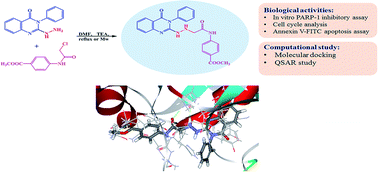Design, synthesis and in silico studies of new quinazolinone derivatives as antitumor PARP-1 inhibitors†
Abstract
Herein, we report an eco-friendly synthesis of a new series of quinazolinone-based derivatives as potential PARP-1 inhibitors. The 4-quinazolinone scaffold was utilized as a bioisostere to the phthalazinone core of the reference compound Olaparib. Most of the synthesized compounds displayed appreciable inhibitory activity against PARP-1. Compound 12c showed inhibitory activity at IC50 = 30.38 nM comparable to Olaparib, which has IC50 = 27.89 nM. Cell cycle analysis was performed for compounds 12a and 12c, and both exhibited cell growth arrest at G2/M phase in the MCF-7 cell line. In addition, both compounds increased the programmed apoptosis compared to the control. Furthermore, molecular docking of the final compounds into the PARP-1 active site was executed to explore their probable binding modes. Also, a computational QSAR and in silico ADMET study was performed. The results of this study revealed that some of the newly synthesized compounds could serve as a new framework to discover new PARP-1 inhibitors with anti-cancer activity.

- This article is part of the themed collection: Computational chemistry


 Please wait while we load your content...
Please wait while we load your content...